Wind power is often touted as a green source of energy, and it’s true that the energy itself comes from a renewable source, i.e. the wind. What about the turbines themselves though? How green are they?
Table of Contents
Whether it’s a giant wind farm turbine or a home wind turbine, the answer is typically the same: most wind turbines just aren’t built sustainably. None of my recommended models get more than 3 leaves because, at the moment, most commercially available wind turbines are made with a lot of plastic and fiberglass and coated with a variety of chemical protectants.
They’re also difficult, if not impossible, to recycle. Some models are better than others, though, which is why they’re included here! Thankfully, some smart designers are working on ways to create fully recycled and recyclable wind turbines that have a far lower environmental footprint over their lifecycle.
If you’re looking for an alternative renewable energy source to lower your electric bills, you could also consider giving solar a shot as well.
How to Choose a Home Wind Turbine
To set up a wind turbine and benefit from it, you’ll need some land, a high voltage battery bank, and some gumption to set it up. Oh, and around $1 per Watt output, i.e. a 600 W turbine costs around $600, and expect to pay about $1500 for a larger 1500 W turbine.
A typical single-family home will require a home wind turbine to generate 5 kW to meet household energy needs. To achieve this, you’re looking at installing a turbine with around a 13-18 foot rotor diameter, and it will need to be placed somewhere with strong winds for most of the year.
If you’ve got little wind where you live (less than 6-7 mph), or have winds that are too strong (over 90 mph), or if you’re just in a densely populated urban area, a wind turbine is not likely to be a good option for you. Solar panels are the way to go in such cases.
Most wind turbines require winds of 27 mph for full energy production. Anything less isn’t maximizing the turbine’s capacity.
You could look for a lower threshold turbine if you live in a less windy area, and a turbine with more blades (9-11, say) can keep the rotor spinning because there’s more torque, weight, and blade surface area overall. A 3-blade model will struggle more in a low wind area.
Check windexchange.energy.gov to figure out if wind power is a viable energy source where you live. The top five wind-producing states are:
- Texas
- Oklahoma
- Kansas
- Iowa
- California
- Starting wind speed (when the blades start turning but don’t produce usable power)
- Cut-in speed (when the blades start turning and producing energy)
- Rated wind speed (when the turbine reaches maximum energy capacity)
- Safe wind speed (i.e. the maximum wind speed before the turbine is vulnerable to wind damage)
As you might imagine, the starting wind speed isn’t all that useful when figuring out the right turbine for your situation. After all, if it never reaches the cut-in speed, all you have is a fancy yard ornament. The rated wind speed is also important to note as this is often the speed used to calculate how much energy could be produced and how much this might offset energy bills.
Realistically, though, you’re unlikely to consistently achieve the rated wind speed and maximum energy production. So, overall, the cut-in speed is probably the most important number to note (along with the safe wind speed if you live in a super windy area).
How Much Energy do you Need Your Turbine to Produce?
Average household energy consumption in the US hovers around 8000-9400 kWh per year. To go off-grid, you’ll need to produce 5-15 kW of power, which isn’t achievable using most home wind turbines. Instead, you can combine several wind turbines and/or wind turbines and solar or microhydro systems.
And, of course, it also pays to make energy upgrades to your home, such as insulation, new windows, draft-proofing, and so forth.
If you aren’t planning on living off-grid and just want a turbine to power a pump for a pond, or the power for a studio in the garden, a turbine only needs to produce some 400-1000 Watts. This is enough to charge small appliances such as your laptop, lights, and power tools.
Realistically, any turbine that produces less than 500 W is a waste of money and time, unless it’s to power lights in a remote location on your property where it’s hard to route a regular power line.
A good general rule is to look for a home wind turbine that can produce at least 1000 W.
Bear in mind that while a 2-megawatt turbine could repay the energy required to produce and install the turbine and yield a net benefit, within 5-8 months of operation, a home wind turbine is far less powerful, with top models generating only around 2,000 W and most clocking in at far less.
How long it takes to pay back your investment depends on how much energy the turbine ends up producing and how much you typically pay for electricity through the grid.
Pairing Wind and Solar to Save More Money
Because it tends to be windiest at night, wind turbines and solar panels make an excellent pairing. This maximizes your day and night energy production and can help you go fully off-grid. Some models of wind turbine and solar panels are designed to work well together and may even be enhanced if you hook them up.
In some cases, you may run into problems with wiring though, with solar arrays needing to be positioned very close to or even on the turbine tower to ensure electrical safety. If you’re thinking of going full bore on the renewables, it’s best to check with the companies making the products to ensure full compatibility prior to buying.
If you’re just trying to harness wind energy, you’ll probably want to choose a higher-power kit generating at least 1500-2000 W. Anything lower is best paired with solar or used to power small applications.
Where to Put Your Wind Turbine
Location, location, location! It’s key for real estate and key for wind turbines. After all, if you put a turbine among a bunch of trees or behind a wall, you’re not going to see those blades spinning.
Most turbines need to be pretty high up to catch good wind. Usually, the mounting pole should rise 25-60 feet in the air or be mounted on your rooftop (if safe). Some models might work in a body of water such as a lake or pond, or by the sea on a cliff-face.
Wherever you’re thinking of mounting the turbine, before you buy, be sure to check your local planning department and any relevant neighborhood association for height restrictions. The last thing you want is to go to the effort and expense of mounting a turbine only to have to take it down the next day after complaints.
If you live on a smaller plot of land, chances are you’ll want a turbine with a smaller rotor radius. For roof mounting, you’ll want one that’s lightweight (in case it does fall) and easy to mount securely.
If you plan on installing more than one wind turbine, check the recommended distance between turbines. This is often larger than you’d think, with some experts recommending ten times the radius between turbines.
Are Wind Turbines Weather Resistant?
Most home wind turbines can handle wind speeds up to 90-110 mph without damage. Some can handle up to 125 mph. So, if you’re in a super windy area, make sure to check ‘survival wind speed’ before buying.
In general, though, it’s best not to install a wind turbine if you live somewhere prone to hurricanes or tornadoes. Wind speeds can easily outstrip survival wind speed and even if the turbine itself is fine it may still come loose from its mount and pose a serious safety hazard. Solar panels are a much better choice for anyone living in such an area.
As for rain-resistance, if your property tends to get lashed by rainstorms, or if you live by a body of water that can cause significant splash where you plan to mount a turbine, you’ll want to choose a marine wind turbine built to be weather-resistant.
Most mid-range turbines are coated with anti-corrosion chemicals. Some are galvanized to resist rust and water damage. These are the ones to choose if you plan to place your turbine in or near water.
Free eBook: Simple Steps to a Greener Home
Concerned about climate change? Learn actionable tips for making each room in your home greener.
"*" indicates required fields
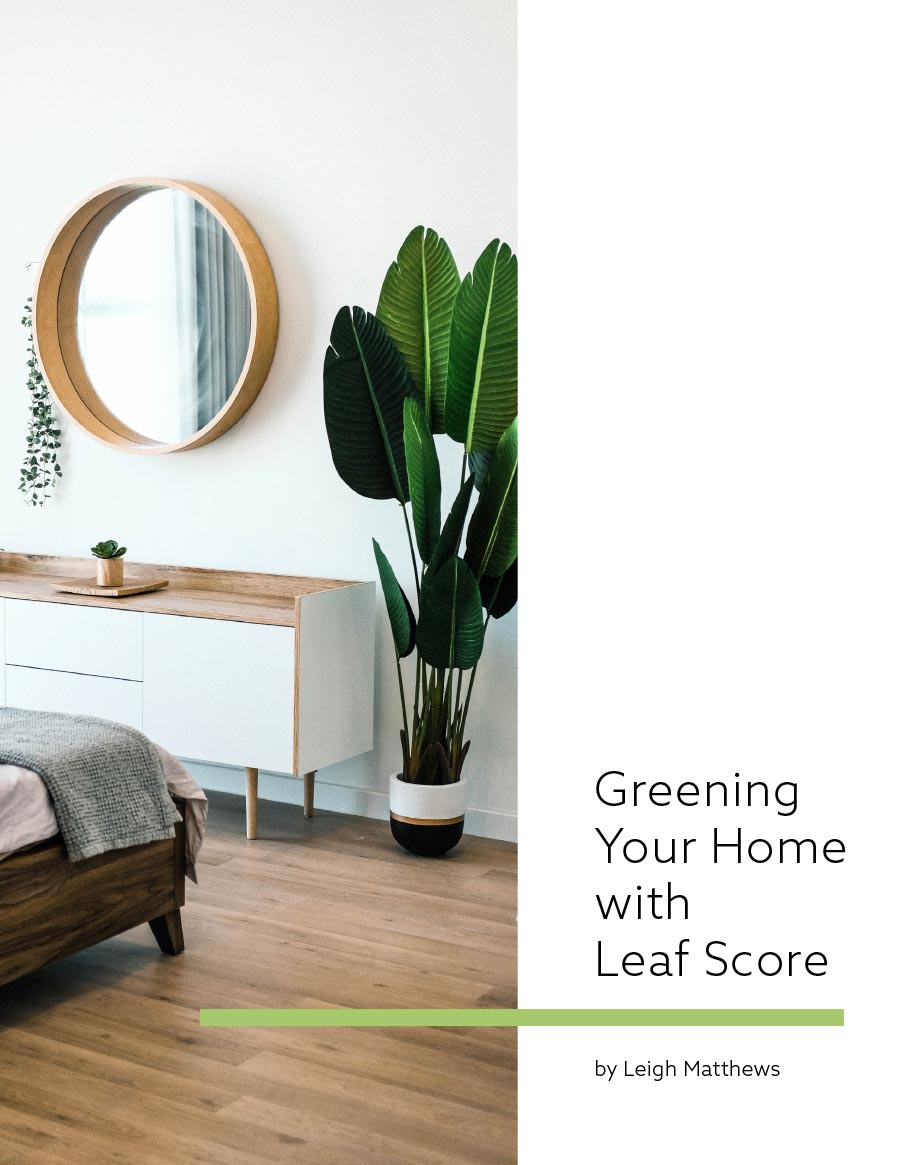
The best wind turbines for home use: our top picks
Curious about how we rate products? Click here to view our methodology, which at its core, is about voting with our dollars to fight climate change.
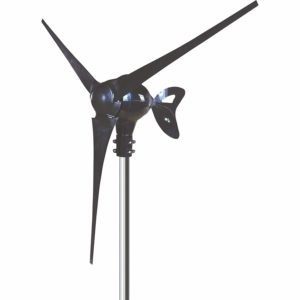
Nature Power 2000 W Marine Wind Turbine Power Generator
Highlights: A great option if you live in an especially wet and windy area or are looking for a turbine to position in or by a body of water or on a boat.
- Rated power: 2000 W
- Voltage: 24 V
- Cut-in Wind Speed: 7 mph
- Wind speed rating: 28 mph Maximum wind speed: 110 mph
The Nature Power Marine Wind Turbine is a great option if you live in an especially wet and windy area or are looking for a turbine to position in or by a body of water or on a boat. It has 3 carbon fiber blades and a body made of durable cast aluminum. It also has overspeed protection and is splash-proof and able to withstand inclement weather.
This turbine is suitable for charging a 24 V battery system for off-grid land and marine applications but has a cut-in speed of 7 mph, meaning it’s only a good fit for fairly windy areas.
It’s fairly easy to install this turbine as there are only 5 parts. That said, you’ll need a minimum 1.5-inch Schedule 40/80 steel pipe and some DIY skills.
You’ll also need a decent amount of cash as this model is quite a bit pricier than other wind turbines. It is sleek though, and is silent too.
The turbine comes with a 3-phase synchronous generator that can charge a 12 V battery and with an inverter you could use it to power a laptop, phone, tools, or lights. In optimal conditions, you may be able to generate enough energy to power a small home or several home appliances.
The blade diameter is 70 inches, so if you’re going to string a few of these together they’ll need to be about 55 feet apart.
The Marine Wind Turbine comes with a limited one-year warranty and is returnable within 180 days. It has a good reputation for performance and reliability and is both strong and sturdy while being lightweight.
This turbine could generate 350 kWh per month with wind speeds of 12 mph on average, and it’s a good fit for very windy areas as it can withstand wind speeds up to 110 mph.
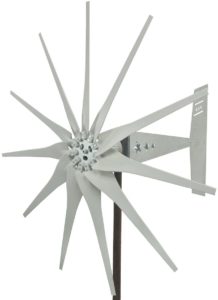
2000 W 11 Blade Missouri General Freedom II Wind Turbine
Highlights: American designed and made, this turbine is made with galvanized parts that won’t rust and don’t need special paint or coatings (that are often toxic). The turbine should last for up to 50 years under normal conditions, according to the company, requires less maintenance than most turbines, can generate power with just 6 mph winds, and could power a small home for off-grid living.
- Rated Power: 2000W
- Voltage: DC12-48V
- Cut-in Wind Speed: 6 mph
- Wind speed rating: 15 mph
- Maximum wind speed: 125 mph
- Rotor diameter: 62 inches (1.57 m)
Available in a 12/24 Volt, 24/48 V, and 48/96 V model, and in 5,7, 9, and 11 blade version, the 2000 Watt 11 Blade Missouri General Freedom II Wind Turbine is a great choice for a home wind turbine that can actually power your whole home.
American designed and made, this turbine comes from a company (Missouri Wind and Solar) with a reputation for being knowledgeable and helpful. The metal components are galvanized and the hub is zinc plated so these parts won’t rust and don’t need special paint or coatings (that are often toxic).
The turbine should last for up to 50 years under normal conditions, according to the company, and requires less maintenance than most turbines.
With 11 blades, this model is a great choice for areas with a lower wind speed as it can reach maximum power output at just 15 mph wind speeds. It still requires a cut-in wind speed of 6 mph though.
The raptor carbon fiber blades are galvanized and built to withstand up to 125 mph winds and are guaranteed for their lifetime under normal use.
This turbine packs a lot of copper in the PMG rotor, which means greater power generation. What’s PMG? That would be permanent magnet generator, and this one has a 28 rare earth magnet rotor inside and skewed stator core for easy turning, with up to 2000 W output.
If you’re looking for a high-quality, powerful wind turbine for your home, the Missouri General Freedom II could well be it.
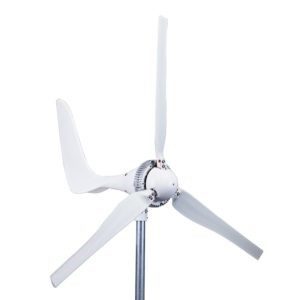
WINDMILL 1500 W Wind Turbine Generator Kit
Highlights: This almost silent, all-in-one, lightweight and high energy-output wind turbine has a built-in charge controller and works in areas of moderate wind (at least 5.6 mph). It can produce 1500 W, enough to power a small off-grid home. Or pair it with a solar array to power a regular home.
- Rated power: 1500 W
- Voltage: 24 VCut-in Wind Speed: 5.6 mph
- Wind speed rating: 31 mph
- Maximum wind speed: 110 mph
- Rotor diameter: 1.7 m
More expensive than many wind turbines, the Windmill 1500W is also one of the most powerful and comprehensive wind generator kits available. Rated at 1500 W, with a cut-in wind speed of 5.6 mph, this turbine can start generating power even with relatively low wind conditions.
The Windmill has a rotor diameter of 1.7 meters, meaning a larger catchment area and greater power generation compared to smaller models. It also has an automatic braking system, so you don’t have to worry about damaging surges of voltage with sudden gusts of wind.
This package includes an MPPT charge controller that makes it super easy to hook up both this turbine and a solar array for a full off-grid power system. This kind of controller is known to be very efficient, ensuring your batteries charge properly.
Unlike the Missouri, this unit is primarily made with polypropylene and fiberglass and is finished with a weather-resistant coating. Installation is relatively easy and the box includes:
- Centerpiece (generator)
- Tail Piece
- MPPT Charge Controller
- 3 x Blades
- Nose cone
- Manual brake switch
- Amp meter display box
- Hex screws, locking nuts, spacers, hex keys
The only additional items needed are a battery pack and a pole for mounting the turbine.
You get a full 1-year warranty with the Windmill, but it’s unlikely you’ll need it as this model appears to be robust and durable. That said, if you do have any issues with the blades or other components, the company has a reputation for responding promptly and replacing parts as needed.
As for noise, this model seems to transfer most of the energy into power generation rather than sound, making it a reasonably silent option for residential neighborhoods.
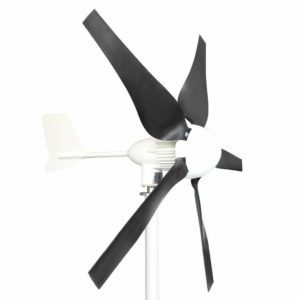
Windmax HY400 500 W Residential Wind Generator Kit
Highlights: A great entry-level, 5-blade model, the Windmax HY400 can generate 500 W at maximum output, meaning this is a good model if you’re only looking to power one or two devices rather than a whole home.
- Rated power: 500 W
- Voltage: 12 V
- Cut-in Wind Speed: 5.6 mph
- Wind speed rating: 27 mph
- Maximum wind speed: N/a (but likely no more than 60 mph)
- Rotor diameter: 1.55 m
A 5-blade model, the Windmax HY400 can generate 500 W at maximum output, meaning this is a good model if you’re only looking to power one or two devices rather than a whole home. Or you could set up a few of these to power a small home, given enough space.
To reach that maximum output, you’ll need wind speeds of 27 mph. To generate any power at all, this turbine needs wind speeds of at least 5.6 mph. The turbine has nylon and reinforced fiberglass blades and an electromagnetic overspeed control to prevent surges in high wind conditions (over 60 mph).
The Windmax is particular good paired with solar panels as it can operate at 650 W when combined with a solar array. To get this set up you’ll need a battery pack and a pole about 25 feet tall.
The turbine comes with a controller and wire measuring 20-30 feet, so don’t plan to mount this any higher.
The Windmax HY400 is a good option if you’re dipping your toes in the water of wind power. Reliable and efficient, with little maintenance required, this turbine can help offset some electricity costs, but don’t expect it to power a full off-grid system. Also, the black and white blades could be a bit of an eyesore depending on your tastes.
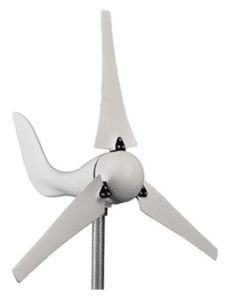
Automaxx Windmill DB 400 W Wind Turbine Generator Kit
Highlights: An inexpensive, budget-friendly turbine that is relatively easy to install and designed for marine and land use.
- Rated power: 400 W
- Voltage: 12 V
- Cut-in Wind Speed: 6.7 mph
- Wind speed rating: 31 mph
- Maximum wind speed: 110 mph
- Rotor diameter: 1.22 m
The Automaxx Windmill DB 400 is another decent option if you’re just looking to explore wind power and want to power a string of lights, a pond pump, or something similar off-grid. With a maximum output of 400 W and a built-in charge controller, this inexpensive turbine is budget-friendly and easy to install. It’s designed for marine and land use as it is coated with protective agents against saltwater corrosion and UV.
The Automaxx comes with a 1-year warranty and has an automatic braking system to prevent surges during powerful gusts of wind. It’s not going to weather very high wind speeds well though, so if you live in an area where you get gusts of 110 mph or more, this probably isn’t the right model for you.
The Best Home Wind Turbine for Apartment Living
If you live in a high-rise and dream of a home wind turbine, a couple of British inventors have just the thing. The problem with windy cities is that the wind is chaotic. Up, down, side to side, this kind of blusteriness means conventional wind turbines don’t work as these require wind coming from a single direction.
The makers of the O-Wind Turbine named their invention for its omnidirectional wind-harvesting capabilities. This 2018 James Dyson Award-Winning contraption is an attractive and strange sphere measuring about 10 inches across. It has vented openings that capture the wind and cause it to spin on a fixed axis. The motion is converted to energy via a small generator, and this energy can power your home or office, or be fed into the grid. Rig up a few of these and you could power large appliances or even your whole apartment.
The downside? The design seems to have stalled in its prototype phase, so it could be a while before it’s brought to market. I’ve reached out to the inventors to see where things are at, but in the meantime, you could look at switching your energy provider to a renewable source and find ways to cut your costs with energy efficient appliances and home energy upgrades. Community solar is another attractive option for renters or those living in apartments, thanks to the fact that it doesn’t require actually installing solar panels where you live.
In the UK, the average wind speed is 4.8mph these wind turbines you’ve put forward as the best 5 for home generation all have a cut in wind speed of over 5mph, so for the majority of the the time, none of these turbines will produce anything (0 watts). The rated wind speed of 27-31mph for 2000watts is ridiculous as it is rarely that windy. Maybe your suggestions should be for real world conditions so wind turbines that have a cut in wind speed of 1-2mph. People may buy one of these turbines you’ve suggested expecting many kWhs per day but will be bitterly disappointed at the miniscule output it produces if any.
Hi Barry,
You’re absolutely right. Home wind tech just isn’t quite there yet for most folks. That’s why these are the ‘best’ of a not overly great selection.
For reference, where I live, on the Sunshine Coast of BC, Canada, wind speed averages about 6 mph year round, with regular wind storms where speeds reach 30-55 mph for several hours. Interestingly, on the other Sunshine Coast (in Queensland, AU), average wind speed is 9.1 miles per hour from the end of December to early April.
So, yeah, most of the time these turbines will be sitting still or barely turning, but when they do move they can produce electricity to help cut down grid-draw. And for folks pairing solar with wind, the turbines are great for keeping things ticking along at night when the sun is down.
By our reckoning, with average wind speeds of about 9 mph and a 1 kW capacity wind turbine, a homeowner could expect to generate 200 kilowatt hours or more annually. With higher wind speeds, this could be 600 kWh or more. It’s not a huge amount, but for net zero (or close) homes, every little helps. Again, as reference, my household electricity use is about 4,500 kWh annually. A 1 kW wind turbine and a 4 kW solar array could meet 100% of our electricity needs. For households with higher energy use, the percentage of power a wind turbine will provide is obviously less, making it less attractive.
Thanks for nerding out with me!
Leigh
Leigh